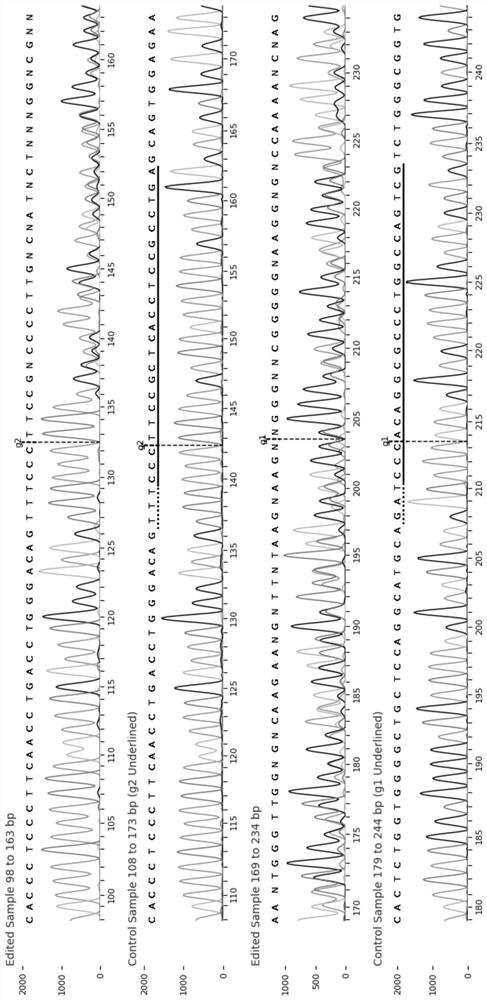Method for knocking out Tim-3 gene to prolong survival of T cell in vivo
A TIM-3, cell technology, applied in the field of genetic engineering, can solve the problems of activation system immune risk and low efficiency, and achieve the effect of enhancing the killing function of T cells, high editing efficiency, and high efficiency transfer.
- Summary
- Abstract
- Description
- Claims
- Application Information
AI Technical Summary
Problems solved by technology
Method used
Image
Examples
Embodiment 1
[0077] An overview of the T cell gene editing method, using CRISPR-Cas9 to specifically knock out the TIM-3 gene in human T cells, specifically includes the following steps:
[0078] 1. Isolation of PBMCs.
[0079] 2. Activate T cells.
[0080] 3. Preparation of RNPs.
[0081] 4. Electric transfer.
[0082] 5. T cell knockout detection.
[0083] The method of the present invention uses CRISPR-Cas9 and sgRNA to specifically knock out the HAVCR2 gene in human T cells to prolong the survival time of T cells.
[0084] Preferred technical points:
[0085] 1) gRNA sequences and combinations, by testing multiple gRNAs and their combinations, determine sequences and combinations with high cleavage activity.
[0086] 2) The process of electroporation of T cells, including determining the method of activating T cells (via OKT3+IL2) and the time point of electroporation (72h after activation). OKT3 (Orthoclone OKT3) is a baiCD3 monoclonal antibody. OKT3 reacts with CD3 on the T cel...
Embodiment 2
[0095] Preparation of tumor-specific and TIM3-T cell products (best embodiment)
[0096] 1. Isolation of PBMCs
[0097] A healthy volunteer named A, who has no symptoms of cold and fever, is recruited. 100 mL of blood was drawn from the cubital vein into BD anticoagulant blood vessels. Blood was mixed with an equal volume of PBS buffer (containing 2% fetal bovine serum). Take the PBMC separation tube Sepmate-50, add 15mL of Ficoll buffer, and then add the blood PBS mixture. Centrifuge at 1200×g for 10 minutes, then quickly pour the supernatant into a new 50mL tube, centrifuge at 200×g for 8 minutes, discard the supernatant, add 10mL PBS buffer to resuspend the pellet, discard the supernatant, add 20mL PBS buffer to resuspend After centrifuging and discarding the supernatant, resuspend all pellets in 10 mL of supernatant PBS buffer. To count the resuspended cells, take 10 μL of the suspension and add 10 μL of 0.1% trypan blue to mix well, count the cell number and surviva...
Embodiment 3
[0117] Effect of TIM3 Knockout on T Cell Retention Time
[0118] 1. Tim3-cell proliferation assay
[0119] TIM3 knockout T cells were cultured with complete medium for 1, 2, 3, 4, 5, and 6 days, and the effect of TIM3 knockout on T cell proliferation was detected by CCK8 method.
[0120] The principle of CCK8: In the CCK-8 kit, the most important ones contain WST-8, 2-(2-methoxy-4-nitrophenyl)-3-(4-nitrophenyl)-5-( 2,4-Disulfonic acid phenyl)-2H-tetrazole monosodium salt. In the presence of electron coupling reagents (that is, cells are alive, respiration, and energy metabolism), it can be oxidized and reduced by NAD+ to form a water-soluble yellow formazan product (Formazan). The more living cells, the more Formazan produced and the darker the color.
[0121] CCK8 method was used to detect the effect of TIM3 knockout on T cell proliferation, and the test method was as follows:
[0122] 1. Prepare 100 μL of cell suspension in a 96-well plate. The culture plate was pre-i...
PUM
 Login to View More
Login to View More Abstract
Description
Claims
Application Information
 Login to View More
Login to View More - R&D
- Intellectual Property
- Life Sciences
- Materials
- Tech Scout
- Unparalleled Data Quality
- Higher Quality Content
- 60% Fewer Hallucinations
Browse by: Latest US Patents, China's latest patents, Technical Efficacy Thesaurus, Application Domain, Technology Topic, Popular Technical Reports.
© 2025 PatSnap. All rights reserved.Legal|Privacy policy|Modern Slavery Act Transparency Statement|Sitemap|About US| Contact US: help@patsnap.com



